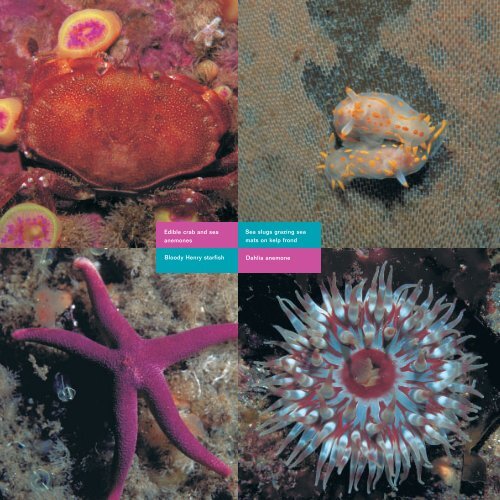Kelp Forests - Scottish Natural Heritage
Kelp Forests - Scottish Natural Heritage Kelp Forests - Scottish Natural Heritage
Edible crab and sea anemones Bloody Henry starfish Sea slugs grazing sea mats on kelp frond Dahlia anemone
Also present on the kelp blades is the translucent blue-rayed limpet, Helcion pellucidum, with its characteristic lines of vivid blue spots, reminiscent in their intensity of the colours of tropical fish. This limpet migrates down to the oarweed holdfast when it grows older; its shell becomes thicker and the colours fade. A wide variety of animals live in the small chambers formed between the branching, root-like holdfast. These include fast-moving Blue-rayed limpet carnivorous bristle worms, with hooked, pincer-like black jaws, slow-moving scale-worms, and small, tube-dwelling crustaceans. Tiny, five-armed brittle stars and small crabs may also be seen. Other animals attach to the rock surface between kelp plants and under boulders. Sponges form splurges of colour or tubular vase or purse shapes under overhanging rocks. Flower-like sea anemones are among the most strikingly coloured and patterned creatures of the shore, and orange or white soft corals, composed of many small polyps contained in a tough, rubbery mass, adorn the kelp stipes and rock surfaces in the shallow sublittoral. 14 The tangle of fronds and stipes of the kelp forest Colonial sea squirts grow as thin sheets over rocks and seaweeds; many minute, brightly coloured individuals are arranged in double rows or starry patterns within a jelly-like matrix. Solitary sea squirts are bag-like animals, up to 7cm or 8cm high; two small openings squirt out water in fine jets when the animal is pressed. Other animals of the oarweed forest live unattached to the rock surface or kelp plants. Close examination of clumps of seaweed may reveal grotesquely armoured sea spiders that feed on hydroids and sea anemones, tearing them apart with hooked pincers. A flash of bright purple or yellow may reveal the presence of a sea slug. Despite their name, these shell-less molluscs are among the most beautiful of marine animals, delicate in form and vividly coloured, although they are often very small. Starfish glide slowly over the boulders between kelp plants, and an occasional sea urchin can be seen sheltering from the sun in the shade of an oarweed blade. A turned-over boulder may reveal a fast-moving blue and red squat-lobster, or an edible crab with ‘pie crust’ markings. When wading through shallow pools or peering under boulders you may disturb a butterfish, and glimpse its brown and black marbled back as it twists its eel-like body. You may also see the spiky-finned shanny, and the rounded, tadpole-like sea snail, which clings to the underside of rocks by means of a sucker.
- Page 1 and 2: Kelp Forests: SCOTLAND’S LIVING L
- Page 3 and 4: Other books in the series: Coasts M
- Page 5 and 6: First published in 1999 by Scottish
- Page 7 and 8: Sea urchins grazing kelp frond
- Page 9 and 10: Kelp holdfast and stipe with feathe
- Page 11 and 12: Kelps occur at and below low-tide l
- Page 13 and 14: Dense cuvie forest
- Page 15 and 16: A second important function of both
- Page 17 and 18: Scottish kelp plants Five kelp spec
- Page 19 and 20: Light - the critical factor Light i
- Page 21: Oarweed forests Butterfish, fanworm
- Page 25 and 26: Cuvie forests At around 1m below lo
- Page 27 and 28: Descending deeper into the sea, the
- Page 29 and 30: 20 Beyond the kelp zone In the dark
- Page 31 and 32: Seals above the kelp forest canopy
- Page 33 and 34: Lumpsucker amongst cuvie stipes fes
- Page 35 and 36: In recent times several thousand to
- Page 37 and 38: Afterword The brown, sunlight-dappl
- Page 39: Also from SNH... Landscape Fashione
Edible crab and sea<br />
anemones<br />
Bloody Henry starfish<br />
Sea slugs grazing sea<br />
mats on kelp frond<br />
Dahlia anemone



